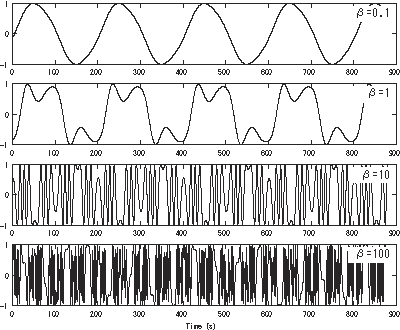Frequency modulation synthesis
From Wikipedia, the free encyclopedia
 |
||
|
||
 |
In audio and music frequency modulation synthesis (or FM synthesis) is a form of audio synthesis where the timbre of a simple waveform is changed by frequency modulating it with a modulating frequency that is also in the audio range, resulting in a more complex waveform and a different-sounding tone. The frequency of an oscillator is altered or distorted, "in accordance with the amplitude of a modulating signal." (Dodge and Jerse 1997, p.115)
For synthesizing harmonic sounds, the modulating signal must have a harmonic relationship to the original carrier signal. As the amount of frequency modulation increases, the sound grows progressively more complex. Through the use of modulators with frequencies that are non-integer multiples of the carrier signal (i.e., non harmonic), bell-like dissonant and percussive sounds can easily be created.
Contents |
[edit] History
The technique, which was discovered by John Chowning (Chowning 1973, cited in Dodge and Jerse, p.115) at Stanford University in 1967-68, was patented in 1975 and later licensed to Yamaha.
It should be noted that the implementation commercialized by Yamaha (US Patent 4018121 Apr 1977) is actually based on phase modulation.
FM synthesis is very good at creating both harmonic and inharmonic ('clang', 'twang' or 'bong' noises) sounds. Complex (and proper) FM synthesis using analog oscillators is not generally feasible due to their inherent pitch instability, but FM synthesis (using the frequency stable phase modulation variant) is easy to implement digitally. As a result, FM synthesis was the basis of some of the early generations of digital synthesizers from Yamaha, with Yamaha's flagship DX7 synthesizer being ubiquitous throughout the 1980s. Yamaha had patented its hardware implementation of FM, allowing it to nearly monopolize the market for that technology. Casio developed a related form of synthesis called phase distortion synthesis, used in its CZ series of synthesizers. It had a similar (but slightly differently derived) sound quality as the DX series.
With the expiration of the Stanford University FM patent in 1995, FM synthesis is now part of the synthesis repertoire of most modern synthesizers, usually in conjunction with additive, subtractive and sometimes sampling techniques.
[edit] Functioning
The harmonic distribution of a simple sine wave signal modulated by another sine wave signal can be represented with Bessel functions - this provides a basis for a simple mathematical understanding of FM synthesis.
FM synthesis is a form of "distortion synthesis" or "nonlinear synthesis". It begins with an oscillator generating an audio-frequency "carrier" waveform with a frequency of Fc . An audio-frequency modulating waveform, with a frequency Fm, is then applied to change or "modulate" the frequency of the carrier oscillator.
If the amplitude of the modulator is 0, the output frequency of the carrier oscillator is simply Fc . Otherwise, the amplitude of the modulating signal causes the frequency of the carrier oscillator to swing above and below Fc . This frequency swing is known as "deviation".
In simple terms, the "louder" the modulating signal is, the more the carrier frequency changes. For illustration, suppose Fc is 1000 Hz. Modulation amplitude might be applied that causes the carrier to swing between 900 Hz and 1100 Hz, that is, 100 Hz in either direction. This is termed a "deviation" of 100 Hz.
At the same time, the frequency of the modulating signal causes what are termed "sideband" frequencies to appear on either "side" of the carrier frequency. Therefore for each frequency component in the modulating signal, an "upper" sideband appears above Fc, and a "lower" sideband appears below Fc. Clearly a modulating waveform containing many frequencies (e.g. "partials") will create many FM sidebands.
Deviation (d) is partly responsible for the power of each component of the output audio signal. When d=0, all the power is heard at the carrier frequency. The larger the deviation, the more power is shifted to the sidebands.
The ratio of deviation to modulation frequency is called the "index of modulation". ( I = d / Fm ) This ratio controls the spectral richness of the sound. By varying deviation through modulation amplitude, and varying the spectrum of the modulating waveform, the resulting audio can be evolved without further instrument complexity. This is the power of FM synthesis.
[edit] References
- J. Chowning (1973). "The Synthesis of Complex Audio Spectra by Means of Frequency Modulation". Journal of the Audio Engineering Society 21 (7).
- Chowning, John; Bristow, David (1986). FM Theory & Applications - By Musicians For Musicians. Tokyo: Yamaha. ISBN 4-636-17482-8.
- Dodge, Charles; Jerse, Thomas A. (1997). Computer Music: Synthesis, Composition and Performance. New York: Schirmer Books. ISBN 0-02-864682-7.
[edit] External links
- An Introduction To FM, by Bill Schottstaedt
- FM tutorial
- SOUNDSHOCK, an English language discussion forum dedicated exclusively to FM Synthesis
- Article: FM Synthesis
- Paul Wiffens Synth School: Part 3
- F.M. Synthesis including complex operator analysis
|
|||||||||||

